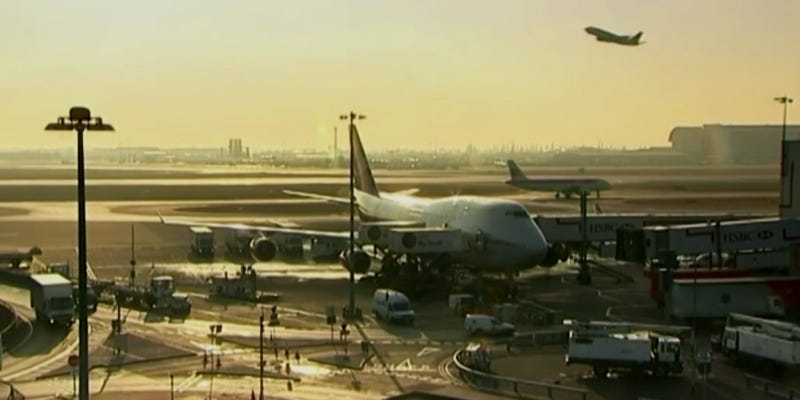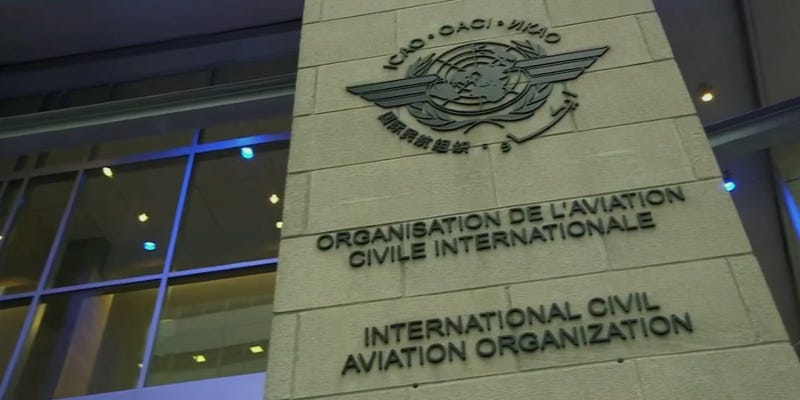Can flying go green? Spoiler alert: No
This week, the British TV programme Panorama asked the question, “Can flying go green?” “Our passion for plane travel is warming the planet,” says Panorama’s reporter, Justin Rowlatt. “Tonight we investigate how the industry is trying to clean up its act, and ask how much can we trust their environmental promises?” About as far as you could throw a jumbo jet is the short answer.
The programme is largely focused on the UK, but also looks at the International Civil Aviation Organisation’s plans to continue expanding, and continue polluting.
Frequent flyers
The British are some of world’s most frequent flyers. “One in twelve of all international flights last year held a UK passport,” Rowlatt says. “More than any other nationality.”
Globally, the number of people flying has quadrupled in the past thirty years. It’s expected to double again by 2037 according to the International Air Transport Agency. By then, the figure will have reached 8.2 billion a year.
By 2050, aviation is expected to become the UK’s biggest emitter, according to the Committee on Climate Change – and that’s “even with strong progress on technology and limiting demand”.
Heathrow is the busiest airport in Europe. Rowlatt interviews Matt Gorman, Heathrow Airport’s Director of Sustainability.
Yes, there really is someone whose job title is “Director of Sustainability” at Heathrow airport.
Gorman tells us that Heathrow is about 98% or 99% full, and that it’s been that way for some time. Last year the UK parliament approved a third runway for Heathrow.
Rowlatt points out that that would make Heathrow the busiest airport ever. Gorman puts on his serious face.
“Well firstly that’s a huge advantage for the UK. But we recognise that we can’t do that at any cost. We’ve got to meet noise targets, we’ve got to meet air quality targets, and we’ve got to meet carbon targets. Climate change is a really pressing issue, and we’re absolutely clear that we have to reach net zero emissions by 2050, like every other part of the economy. That’s what the science is telling us.”
That simply isn’t true. The science is telling us that we have to dramatically reduce emissions from burning fossil fuels. “Net zero” is no more than an attempt to “fool nature”, as Kevin Anderson, Professor of Energy and Climate Change at the University of Manchester, puts it.
Sustainable aviation fuel?
Rowlatt interviews Michael O’Leary, CEO of Ryanair:
“If the aviation industry had any alternative to jet kerosene, we would use it in a flash. Fuel last year accounted for nearly 30% of my cost base. But we don’t have an alternative. Electric batteries to get an aircraft off the ground doesn’t have the propulsion.”
British Airways and Shell are investing millions into a company called Velocys that is working on producing “sustainable aviation fuel” from household waste. Rowlatt notes that this sounds good, but points out that, “emissions from the engine will stay the same”.
Also, there’s nowhere near enough of this so-called “sustainable aviation fuel”. Initially it will be blended with kerosene, which will still make up more than half the final fuel.
Rowlatt interviews Professor David Lee at Manchester Metropolitan University, who tells us we’re still decades away from having a ready supply of sustainable fuels:
“The aviation industry needs to take it a lot more seriously and they need to be demanding that governments take policy measures that forces the whole system to produce zero carbon fuel. Because that’s the only way out.”
Fuel tankering
Panorama exposes the industry-wide practice of “fuel tankering”. Planes are filled with extra fuel to avoid buying fuel at destination airports where it is more expensive. While it saves the airlines money, the extra weight of the fuel means more emissions.
When the aviation industry says it’s doing everything it can to reduce emissions, it is lying.
Ryanair’s offsets
In 2018, Ryanair launched a voluntary carbon offsets scheme. The money goes to four projects: an efficient cookstove project in Uganda; a 250 hectare forest restoration project in a fire damaged area in Portugal; an ancient Irish woodland tree planting project; and an Irish whale and dolphin tracking project.
The last isn’t an offset scheme at all. The cookstoves project in Uganda offsets much more than the trees. “But over a year it’s still only the equivalent of a week of Ryanair’s annual emissions,” Rowlatt tells us.
Rowlatt visits the tree planting project in Ireland. Ryanair has helped the Native Woodland Trust, an Irish charity, buy an area of land near an ancient woodland. The Native Woodland Trust will collect seeds from the ancient woodland and plant trees to expand the area of woodland.
“They’ve taken this ancient woodland,” Rowlatt says, “and they’re growing more of it. I mean, it’s absolutely wonderful. But if one of the objectives is to offset carbon then there is a big problem. There just isn’t enough of it.”
Rowlatt interviews Professor Simon Lewis of University College London. Lewis calculates how much carbon the tree planting schemes in Ireland and Portugal would remove from the atmosphere. It is not impressive.
For each of the next 20 years, the tree projects would offset less than 0.01% of this year’s emissions. To offset all of Ryanair’s 2019 emissions would require planting an area of about 12% of the UK with trees. Lewis says,
“The Irish scheme is really tiny. It’s just seven hectares. It’s not even the size of a small farm. . . .
“They’re woefully inadequate in terms of the scale of these schemes compared to the amount of emissions that have been generated from the flights. It’s a drop in the ocean. To me, that’s a gimmick. It’s a green gimmick rather than a serious attempt to slow down climate change.”
Rowlatt points out to Ryanair’s O’Leary that the offsetting scheme nowhere near meets Ryanair’s emissions. “Absolutely wrong,” O’Leary replies.
“From little acorns grow mighty trees. We only started this in the last year. We’re working with four projects. We’re replanting trees in Monchique in Portugal, we’re supporting whales and dolphins in Ireland.”
Rowlatt interrupts him to point out that the whales and dolphins project has nothing to do with carbon dioxide.
“No, but it’s good for the environment. I don’t think any of our customers would object to supporting wales and dolphins in Ireland. . . .
“This is a small programme that started in the last year. All it does is a gesture. It’s no more than that. And 3% of our passengers are good enough to contribute €1 per ticket into that programme.”
Rowlatt interviews Tim Johnson of the Aviation Environment Federation. He asks Johnson whether you can pay £1 and hope to absolve yourself of responsibility for the carbon emissions that you’ve created. “Not at all,” Johnson replies, and points out that the emissions from flying will remain in the atmosphere for hundreds of years to come.
CORSIA: Aviation’s offsetting scam
The Panorama team fly to Montreal for the 40th Assembly of the International Civil Aviation Organisation.
Rowlatt explains CORSIA, the Carbon Offsetting and Reduction Scheme for International Aviation, as follows:
“Under the new deal, next year participating countries will add up all their annual carbon dioxide emissions from international flights. Then from 2021, when emissions go over that level the airlines will have to pay to offset them. . . .
“CORSIA is only designed to deal with the growth in emissions, so the vast majority of carbon dioxide won’t be offset. What’s more, lots of countries, including China and Russia won’t take part until 2027.”
Of course the aviation industry isn’t interested in hearing any criticism of CORSIA. Michael Gill of the International Air Transport Association tell us that,
“CORSIA was a political compromise between the 193 governments with input from the industry, reflecting some of the realities of the aviation sector. We actually think it’s a very good deal, because it has the buy-in from everybody.”
Rowlatt interviews Annie Petsonk of the Environmental Defense Fund. Petsonk is in favour of carbon offsetting – the word “environmental” in her employer’s name is clearly a misnomer:
“If you added up the emissions of all the flights in the world aviation would be a top ten emitter. Aviation’s emissions are projected to double, triple, potentially even quadruple in the coming decades as more and more big aircraft take to skies. . . .
“The negotiations on CORSIA were very difficult, with some countries saying, ‘We cannot meet a 2020 target our airlines need to grow in the future.’ And others saying if we cannot limit the carbon dioxide emissions of our aircraft, the future of our industry is in jeopardy. . . .
“CORSIA has the potential to be a good scheme as airlines see that they’re going to have to pay for carbon pollution, for the first time ever. They are scrambling to find how to cut emissions inside their operations.”
Rowlatt interviews Andrew Murphy from the NGO Transport & Environment. Murphy points out that offsets don’t work:
“We’ve had about 20 years experience globally of trying to make offsetting work and what we’ve had is wind farms that were going to be built anyway, trees that ended up being burned down anyway. It’s not working as a climate tool. But at the same time the aviation industry is increasingly seeing offsetting as essentially its get-out-of-jail-card for climate policy.”
The only option, Rowlatt concludes, is for governments to get tougher. Murphy says,
“Ultimately, if we’re going to solve climate change, it’s going to come from the ambitious countries getting together and taking action on things like taxing aviation, on new fuels, on slowing growth, on blocking airport expansions.”








